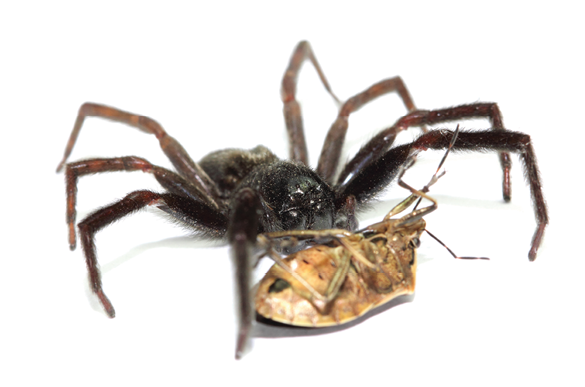Interview by Karen E. Varga

This past December, the EPA removed the bee toxicity label from SPEAR-T, a bioinsecticide developed by Vestaron Corporation. The removal of the label means the product showed no increased mortality or detrimental effects of honeybees.
“It’s exciting to unveil our more environmentally compatible biopesticides, which for the first time, perform comparably to synthetic insecticides,” said Robert Kennedy, chief scientific officer at Vestaron at a talk at AgChem Summit 2015 in Arlington, Va. that same month.
We sat down with Vestaron CEO Dr. John Sorenson to tell us more about SPEAR-T and the innovative ways the company is conducting its research.
Greenhouse Management: Will you please first tell us a little bit about how Vestaron Corporation came to be?
Dr. John Sorenson: We were founded as a result of some research that was done by Dr. Glenn King, who, at the time, was at the University of Connecticut. He was studying spider venoms and the components that make up spider venoms, and realized that even though there were components of spider venom that are toxic to humans — and mammals — and other things, that there were many components that were not toxic to humans. So that was the founding inspiration for our company, to look for biological insecticides, which were hell on insects, but did not have the toxicity for mammals, birds, fish, honeybees, or anything else, as it turns out.
GM: Can you tell us about the award you received last year?

JS: We won the Inaugural Bernard Blum Award, and this [is] an award that is given for the leading innovative biocontrol compound of the year, so we’re very honored to receive this award. Bernard Blum was one of the pioneers of biocontrol. It was named after him, and we feel very fortunate to have won it.
GM: Tell me about the products you have available for greenhouse growers.
JS: We’re going to be introducing our first product this year, SPEAR-T. It’s for control of thrips and whiteflies, and it is dynamite. It’s a biological insecticide, but it performs [well] in contrast to most biologicals, which have reduced efficacy, compared to synthetic chemistry …. In addition, thrips are great at overcoming chemistry. They’re developing resistance to chemistry, and our product has not one, but two different modes of action which have never before been used in an insecticide.
GM: Could you explain some of the science behind SPEAR-T, in layman’s terms?
JS: We [started with] spider venom, a complex cocktail that’s composed of up to 1,000 peptides. We initially looked for those [peptides] that had great insect-killing power, but were nontoxic to mammals. We’ve since determined that they’re nontoxic to most other things, [too]. And then we isolate or synthesize the genes that code for those, put those in yeast, and that’s our production system. The yeast secretes the peptide of interest — or small protein of interest — and we do a couple of filtration steps, and that’s basically the formulation of our peptide.
GM: How did spider venom come about? It’s not exactly what someone would think of off-hand as a pest control tool.
JS: Spiders kill insects, or they don’t eat. They’ve become very good at it over the millennia of evolution. So that was an intriguing place to look for a bioinsecticide. [So] we looked there, and lo and behold, we found it. We’ve since found that these really small proteins — or peptides — have a unique structure, and that structure is conserved in the venoms of many, many creatures. So all spiders, scorpions, sea anemones, snakes, [etc.], have venoms composed of these peptides. So it opens up a tremendous drove of potential targets for bioinsecticides. And we’re busily incorporating those into our product development process, and looking at things beyond spider venom.
GM: So how does SPEAR-T kill insects?
JS: [SPEAR-T] actually has two modes of action that are unrelated to each other. In integrated pest management, one of the cardinal rules is the more modes of action you can use in your rotational program, the better off you are. So we have [a] two-in-one product that should make it a tougher job for the thrips to develop resistance to it.
GM: What are those modes of action?
JS: They’re effective against what are called ion channels, which regulate the flow of ions into and out of cells, and their calcium channel and [also the] potassium channel … They block the passage of ions into cells, and therefore they cause muscle paralysis in the insect, and eventual death.

GM: How does SPEAR-T not hurt honeybees, but work as an effective biopesticide?
JS: Well, we don’t know exactly. [Regarding] the peptides themselves, there are several classes of insects they’re not effective against. They’re not effective against mites, for example, and apparently, hymenoptera, which is the order that bees are in, are not affected by the toxins. It’s a matter of luck, but good fortune smiles on us every now and again.
GM: Will you explain the potential for resistance?
JS: There’s a constant war that goes on between insects and man. Man comes up with chemicals, and insects develop resistance. It’s very much like antibiotics and bacteria. But we’re learning.
[But] we think by first of all, having two modes of action in one chemical, and by rotating this with other modes of action from other chemicals, we really provide a challenge for the insects to become resistant. Not to say they won’t over time, but it will be a much more difficult task for them.

Explore the March 2016 Issue
Check out more from this issue and find you next story to read.
Latest from Greenhouse Management
- CIOPORA appoints Micaela Filippo as vice secretary-general
- Passion grows progress
- Registration opens for Darwin Perennials Day
- U.S. Department of Labor finalizes farmworker protection rule
- Azo Root is now available from Harrell’s
- Bidens ferulifolia Blazing Glory
- Rob Hanifin joins Ridder North America as product specialist for climate screens
- The importance of measuring light





